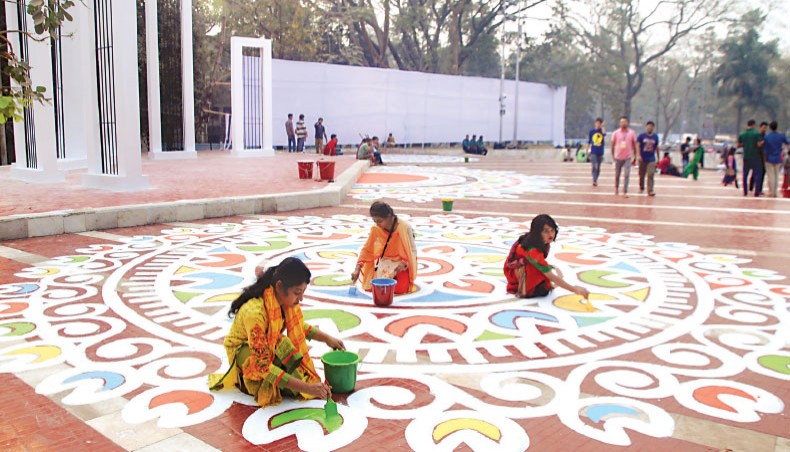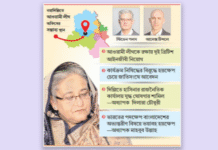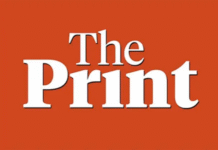Country wide Amar Ekushey celebrations begin one minute past midnight tonight with the nation paying homage to 1952 language movement heroes.
Wreaths would be laid on the altar of the Central Shaheed Minar in the capital
and elsewhere across Bangladesh to commemorate the supreme sacrifice of the heroes of the historic language movement amid tight security.
The Central Shaheed Minar has been adorned with the Bangla alphabet keeping the rising sun in the backdrop.
Since February 21, 1952, the day has been observed as Shaheed Dibash, or the day of the language martyrs, whose supreme sacrifice inspired the nation to fight for its rights and ultimately to clinch independence.
Since 2000 the day has been globally celebrated as the International Mother Language Day.
In November 1999, UNESCO declared February 21 as the International Mother Language Day in recognition of the sacrifice and struggle of the Bangalis to achieve the right to speak in their own language.
On February 21, 1952, corresponding to Phalgun 8, 1359 according to the Bangla calendar, the then rulers of Pakistan, of which Bangladesh was a part, in a bid to make Urdu the lone state language banned any protests.
Students of Dhaka University refused to accept the imposition as Bangalis were the majority population in the country and took to the streets defying the ban on five or more people getting together on streets and other public places.
And on February 21,1952, Salam, Jabbar, Rafiq and Barkat gave life in police firing on the protest march of students in defiance of the ban and in support of the demand to make Bangla as one of the state languages of Pakistan.
The historic language movement inspired the Bangali nation to continue movements for autonomy, removal of economic disparity between provinces, the launching of six-point movement in 1966 which stressed separate economies for the then East and the West Pakistan, the 1969 mass upsurge culminating in the War of Independence in 1971.
Dhaka University, as in the past, would organize the Ekushey celebrations in the capital.
DU proctor and celebration committee member secretary AM Amzad said that the preparations for the historic day’s celebrations had been completed.
DU Fine Arts Faculty students painted the Central Shaheed Minar, its altar, the paths leading to it and the walls around the hallowed cenotaph with floral motifs.
National flag has been hoisted on the streets leading to the Central Shaheed Minar bedecked with festoons and cardboard cut-outs of the Bangla alphabet.
People from all walks of life will lay wreaths at Central Shaheed Minar singing in chorus ‘Amar Bhaiyer Rakte Rangano Ekushey February, Ami ki Bhulite Pari.
They would observe silence for a while on the altar of the cenotaph to pay respects to the language movement heroes.
President Abdul Hamid would be first to lay wreaths at the Central Shaheed Minar to be followed by prime minister Sheikh Hasina and her cabinet colleagues, the speaker and the chief justice.
BNP chairperson Khaleda Zia and leader of the opposition Raushan Ershad are also expected to lay wreaths at the Central Shaheed Minar as a mark of respect to the language movement heroes.
Dhaka Metropolitan Police commissioner Asaduzzman Mia said that the police would put in place four tier security at and around the Central Shaheed Minar.
No traffic movement would allowed on the streets and lanes leading to the Central Shaheed Minar from 6PM Monday to 2PM Tuesday but for the vehicles with authorized stickers.
The DU requested homage payers to take the street in front of old High Court Building via the Doyel Crossing, Bangla Academy, the TSC intersection, road passing by the official residence of DU vice chancellor, Nilkhet Police Box and the , New Market Crossing for reaching the Azimpur Graveyard, where the language martyrs are buried.
For those not planning to visit Azimpur Graveyard, the road passing by the left side of Nilkhet Police Box Crossing leading to Salimullah Muslim Hall, Jagannath Hall would remain open for reaching the Central Shaheed Minar.
From the New Market Crossing the road passing by Home Economics College and Eden Girls’ College, Baby Ice Cream Crossing, Plassey Crossing would also remain open to the homage Payers so that they can reach the Shaheed Minar keeping the Salimullah Muslim Hall and Jagannath Hall on the left.
Homage payers will allowed to reach the Shaheed Minar using Chankhar Pul, Bakshi Bazaar Crossing, the road on the south of BUET, the roads in front of Salimullah Muslim Hall and Jagannath Hall.
Wreaths would be laid on the altar of the Central Shaheed Minar in the capital
and elsewhere across Bangladesh to commemorate the supreme sacrifice of the heroes of the historic language movement amid tight security.
The Central Shaheed Minar has been adorned with the Bangla alphabet keeping the rising sun in the backdrop.
Since February 21, 1952, the day has been observed as Shaheed Dibash, or the day of the language martyrs, whose supreme sacrifice inspired the nation to fight for its rights and ultimately to clinch independence.
Since 2000 the day has been globally celebrated as the International Mother Language Day.
In November 1999, UNESCO declared February 21 as the International Mother Language Day in recognition of the sacrifice and struggle of the Bangalis to achieve the right to speak in their own language.
On February 21, 1952, corresponding to Phalgun 8, 1359 according to the Bangla calendar, the then rulers of Pakistan, of which Bangladesh was a part, in a bid to make Urdu the lone state language banned any protests.
Students of Dhaka University refused to accept the imposition as Bangalis were the majority population in the country and took to the streets defying the ban on five or more people getting together on streets and other public places.
And on February 21,1952, Salam, Jabbar, Rafiq and Barkat gave life in police firing on the protest march of students in defiance of the ban and in support of the demand to make Bangla as one of the state languages of Pakistan.
The historic language movement inspired the Bangali nation to continue movements for autonomy, removal of economic disparity between provinces, the launching of six-point movement in 1966 which stressed separate economies for the then East and the West Pakistan, the 1969 mass upsurge culminating in the War of Independence in 1971.
Dhaka University, as in the past, would organize the Ekushey celebrations in the capital.
DU proctor and celebration committee member secretary AM Amzad said that the preparations for the historic day’s celebrations had been completed.
DU Fine Arts Faculty students painted the Central Shaheed Minar, its altar, the paths leading to it and the walls around the hallowed cenotaph with floral motifs.
National flag has been hoisted on the streets leading to the Central Shaheed Minar bedecked with festoons and cardboard cut-outs of the Bangla alphabet.
People from all walks of life will lay wreaths at Central Shaheed Minar singing in chorus ‘Amar Bhaiyer Rakte Rangano Ekushey February, Ami ki Bhulite Pari.
They would observe silence for a while on the altar of the cenotaph to pay respects to the language movement heroes.
President Abdul Hamid would be first to lay wreaths at the Central Shaheed Minar to be followed by prime minister Sheikh Hasina and her cabinet colleagues, the speaker and the chief justice.
BNP chairperson Khaleda Zia and leader of the opposition Raushan Ershad are also expected to lay wreaths at the Central Shaheed Minar as a mark of respect to the language movement heroes.
Dhaka Metropolitan Police commissioner Asaduzzman Mia said that the police would put in place four tier security at and around the Central Shaheed Minar.
No traffic movement would allowed on the streets and lanes leading to the Central Shaheed Minar from 6PM Monday to 2PM Tuesday but for the vehicles with authorized stickers.
The DU requested homage payers to take the street in front of old High Court Building via the Doyel Crossing, Bangla Academy, the TSC intersection, road passing by the official residence of DU vice chancellor, Nilkhet Police Box and the , New Market Crossing for reaching the Azimpur Graveyard, where the language martyrs are buried.
For those not planning to visit Azimpur Graveyard, the road passing by the left side of Nilkhet Police Box Crossing leading to Salimullah Muslim Hall, Jagannath Hall would remain open for reaching the Central Shaheed Minar.
From the New Market Crossing the road passing by Home Economics College and Eden Girls’ College, Baby Ice Cream Crossing, Plassey Crossing would also remain open to the homage Payers so that they can reach the Shaheed Minar keeping the Salimullah Muslim Hall and Jagannath Hall on the left.
Homage payers will allowed to reach the Shaheed Minar using Chankhar Pul, Bakshi Bazaar Crossing, the road on the south of BUET, the roads in front of Salimullah Muslim Hall and Jagannath Hall.
Source: New Age










